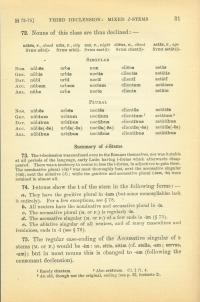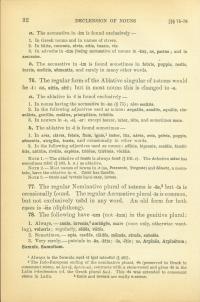73. The i-declension was confused even to the Romans themselves, nor was it stable at all periods of the language, early Latin having i-forms which afterwards disappeared. There was a tendency in nouns to lose the i-forms, in adjectives to gain them. The nominative plural (-īs)1 was most thoroughly lost, next the accusative singular (-im), next the ablative (-ī); while the genitive and accusative plural (-ium, -īs) were retained in almost all.
74. I-stems show the i of the stem in the following forms:
a. They have the genitive plural in -ium (but some monosyllables lack it entirely). For a few exceptions, see § 78 below.
b. All neuters have the nominative and accusative plural in -ia.
c. The accusative plural (m. or f.) is regularly -īs.
d. The accusative singular (m. or f.) of a few ends in -im (§ 75 below).
e. The ablative singular of all neuters, and of many masculines and feminines, ends in -ī.
75. The regular case-ending of the accusative singular of i-stems (m. or f.) would be -im.
sitis, sitim (cf. stella, -am; servus, -um)
But, in most nouns this is changed to -em (following the consonant declension).
a. The accusative in -im is found exclusively—
1. In Greek nouns and in names of rivers.
2. In būris, cucumis, rāvis, sitis, tussis, vīs.
3. In adverbs in -tim (being accusative of nouns in -tis), as, partim; and in amussim.
b. The accusative in -im is found sometimes in febris, puppis, restis, turris, secūris, sēmentis, and rarely in many other words.
76. The regular form of the ablative singular of i-stems would be -ī.
sitis, sitī
But, in most nouns this is changed to -e.
a. The Ablative in -ī is found exclusively—
1. In nouns having the Accusative in -im (§ 75 above); also secūris.
2. In the following adjectives used as nouns.
aequālis, annālis, aquālis, cōnsulāris, gentīlis, molāris, prīmipīlāris, tribūlis
3. In neuters in -e, -al, -ar except: baccar, iubar, rēte, and sometimes mare.
b. The Ablative in -ī is found sometimes—
1. In avis, clāvis, febris, fīnis, īgnis,1 imber, lūx, nāvis, ovis, pelvis, puppis, sēmentis, strigilis, turris, and occasionally in other words.
2. In the following adjectives used as nouns.
affīnis, bipennis, canālis, familiāris, nātālis, rīvālis, sapiēns, tridēns, trirēmis, vōcālis
Note 1— The ablative of famēs is always famē (§ 105.e). The defective māne has sometimes mānī (§ 103.b Note) as ablative.
Note 2— Most names of towns in -e (as, Praeneste, Tergeste) and Sōracte, a mountain, have the ablative in -e. Caere has Caerēte.
Note 3— Canis and iuvenis have cane, iuvene.
77. The regular nominative plural of i-stems is -ēs,1 but -īs is occasionally found. The regular accusative plural -īs is common, but not exclusively used in any word. An old form for both cases is -eis (diphthong).
78. The following have -um (not -ium) in the genitive plural.
- Always— canis, iuvenis,2 ambāgēs, mare (once only, otherwise wanting), volucris.
- Regularly— sēdēs, vātēs
- Sometimes— apis, caedēs, clādēs, mēnsis, struēs, subolēs
-
Very rarely— patrials in -ās, -ātis; -īs, -ītis.
Arpīnās, Arpīnātum, Samnīs, Samnītum
Footnotes
1. The Indo-European ending of the Nominative plural, -ĕs (preserved in Greek in consonant stems, as ὄρτυξ, ὄρτυγ-ες), contracts with a stem-vowel and gives -ēs in the Latin i-declension (cf, the Greek plural ὄεις ). This -ēs was extended to consonant stems in Latin.
2.Canis and iuvenis are really n-stems


